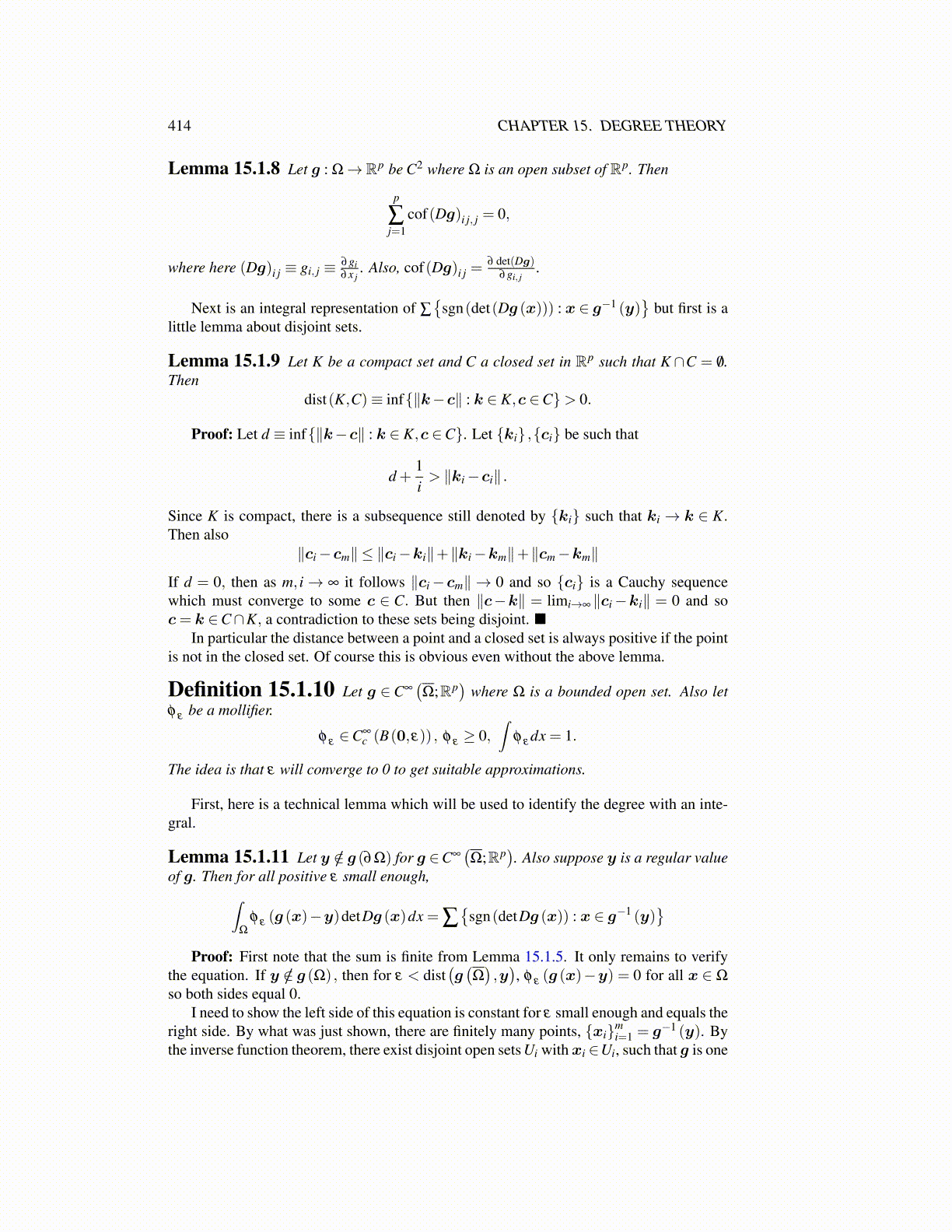
414 CHAPTER 15. DEGREE THEORY
Lemma 15.1.8 Let g : Ω→ Rp be C2 where Ω is an open subset of Rp. Then
p
∑j=1
cof(Dg)i j, j = 0,
where here (Dg)i j ≡ gi, j ≡ ∂gi∂x j
. Also, cof(Dg)i j =∂ det(Dg)
∂gi, j.
Next is an integral representation of ∑{
sgn(det(Dg (x))) : x ∈ g−1 (y)}
but first is alittle lemma about disjoint sets.
Lemma 15.1.9 Let K be a compact set and C a closed set in Rp such that K ∩C = /0.Then
dist(K,C)≡ inf{∥k−c∥ : k ∈ K,c ∈C}> 0.
Proof: Let d ≡ inf{∥k−c∥ : k ∈ K,c ∈C}. Let {ki} ,{ci} be such that
d +1i> ∥ki−ci∥ .
Since K is compact, there is a subsequence still denoted by {ki} such that ki → k ∈ K.Then also
∥ci−cm∥ ≤ ∥ci−ki∥+∥ki−km∥+∥cm−km∥
If d = 0, then as m, i→ ∞ it follows ∥ci−cm∥ → 0 and so {ci} is a Cauchy sequencewhich must converge to some c ∈ C. But then ∥c−k∥ = limi→∞ ∥ci−ki∥ = 0 and soc= k ∈C∩K, a contradiction to these sets being disjoint. ■
In particular the distance between a point and a closed set is always positive if the pointis not in the closed set. Of course this is obvious even without the above lemma.
Definition 15.1.10 Let g ∈ C∞(Ω;Rp
)where Ω is a bounded open set. Also let
φ ε be a mollifier.
φ ε ∈C∞c (B(0,ε)) , φ ε ≥ 0,
∫φ ε dx = 1.
The idea is that ε will converge to 0 to get suitable approximations.
First, here is a technical lemma which will be used to identify the degree with an inte-gral.
Lemma 15.1.11 Let y /∈ g (∂Ω) for g ∈C∞(Ω;Rp
). Also suppose y is a regular value
of g. Then for all positive ε small enough,∫Ω
φ ε (g (x)−y)detDg (x)dx = ∑{
sgn(detDg (x)) : x ∈ g−1 (y)}
Proof: First note that the sum is finite from Lemma 15.1.5. It only remains to verifythe equation. If y /∈ g (Ω) , then for ε < dist
(g(Ω),y), φ ε (g (x)−y) = 0 for all x ∈ Ω
so both sides equal 0.I need to show the left side of this equation is constant for ε small enough and equals the
right side. By what was just shown, there are finitely many points, {xi}mi=1 = g
−1 (y). Bythe inverse function theorem, there exist disjoint open sets Ui withxi ∈Ui, such that g is one